
Painting, Photo, New Media, Drawing, Sculpture, Fiction, Guqin, Cigar Box Guitar, Film+Animation, Performance, Architecture, Wearable Art, Cabinet of Curiosity, Toys, Games, Virtual World
Tuesday, September 30, 2014
Monday, September 29, 2014
New Media : Reading, "Hackers & Painters" by Paul Graham; Picture books
http://groundwoodbooks.com/

Nobody knows, the film and the book

http://it-ebooks.info/book/247/

Nobody knows, the film and the book

http://it-ebooks.info/book/247/
Hackers & Painters
Big Ideas from the Computer Age
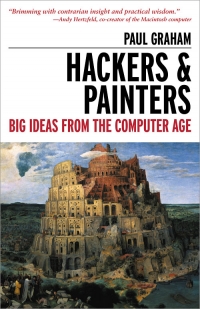

QR Code |
Book DescriptionWritten in clear, narrative style, Hackers & Painters examines issues such as the rightness of web-based applications, the programming language renaissance, spam filtering, the Open Source Movement, internet startups and more. In each essay, Graham moves beyond widely held beliefs about the way that programmers work as he tells important stories about the kinds of people behind tech innovations, revealing distinctions about their characters and their craft. No hackers reading this book will fail to recognize themselves within these pages. No programmer will put it down without new thoughts actively percolating.
| ||||||||||||||||||||||||
Joni mitchell; picture book : what there is before there is anything there
http://www.brainpickings.org/
Joni Mitchell : interview on creativity
She revisits this notion of creating from a place of freedom rather than normative restriction based on the ideals and shoulds of others:

But Mitchell's most salient reflection is also her most vulnerable.
Looking back on her journey from poverty to affluence, from critical
derision to acclaim, she speaks to the rather conflicted relationship
many of us – especially artists of all stripes – have with success and
its outward expressions, a tension predicated on the toxic myth that
there is a nobility to poverty and that financial success necessarily
detracts from the authenticity of the work.
When Maron notes that "once you’ve known poverty, it digs into you no matter how successful," Mitchell agrees and admits to being "suspicious of wealth" because she had come from destitution. Looking back on that tipping point when she went from struggling artist to star, with the affluent lifestyle to boot, she contemplates the inner tussle of values:

 a>
a>
:: MORE / SHARE ::
http://www.brainpickings.org/
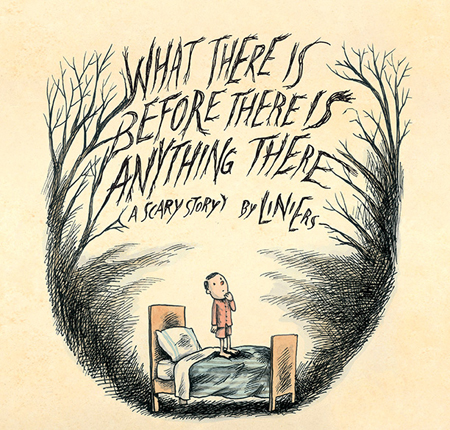 Children often wonder about why we dream, as do some dedicated researchers, but the question of why we have nightmares
is as perplexing to scientists — some of humanity’s most intelligent
grownups — as it is exasperating to kids. Indeed, nightmares, along with
its sister fear of the dark, are among childhood’s most anguishing and
common experiences, as exasperating to the child experiencing them as to
his or her parents in their helplessness of assuaging them.
Children often wonder about why we dream, as do some dedicated researchers, but the question of why we have nightmares
is as perplexing to scientists — some of humanity’s most intelligent
grownups — as it is exasperating to kids. Indeed, nightmares, along with
its sister fear of the dark, are among childhood’s most anguishing and
common experiences, as exasperating to the child experiencing them as to
his or her parents in their helplessness of assuaging them.
That’s precisely what award-winning Argentinian cartoonist and New Yorker cover artist Liniers (whose beloved Macanudo series was just released in English for the first time) explores in What There Is Before There Is Anything There: A Scary Story (public library) — a wonderful picture-book that brings dark humor to those familiar nighttime fears while taking them seriously, at once spooky and sweet in its solidarity of acknowledging that they are very much real, even if their objects are not true. One of the great injustices of childhood, after all, is the recurring experience of not being believed by grownups, not being validated in one’s fears and fancies and subjective truths simply because one is a child. Liniers refuses to negate the realness of those childhood fears and instead meets them with equal parts reassurance, imagination, and gentle wit, in a style reminiscent of Edward Gorey yet distinctively his own.
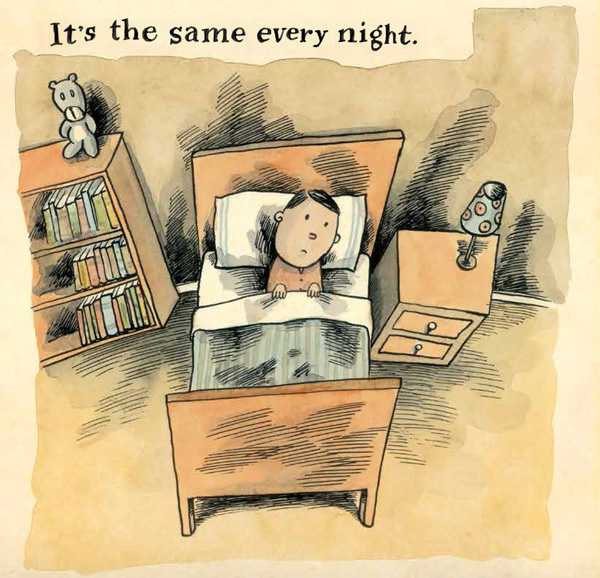
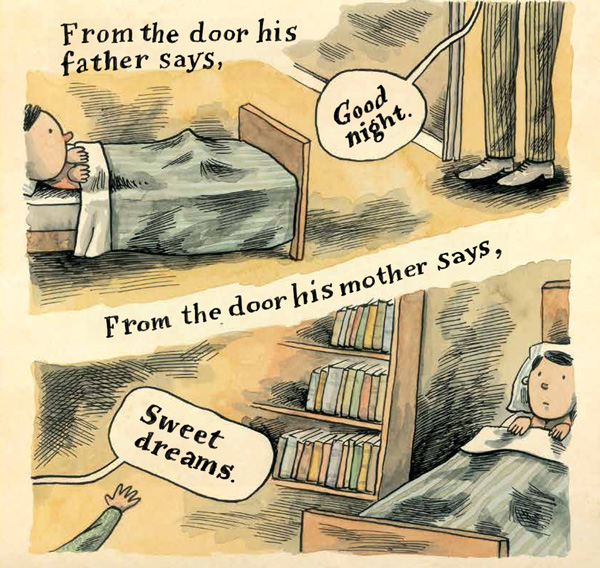
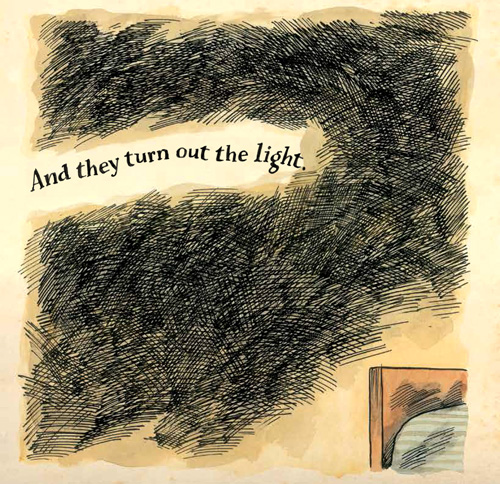
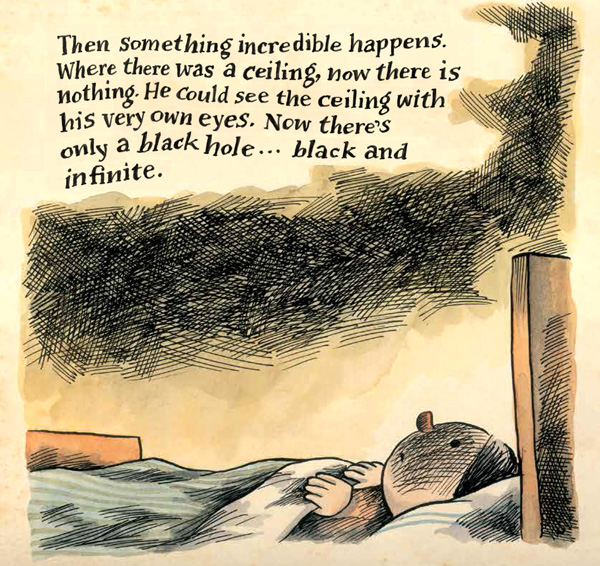
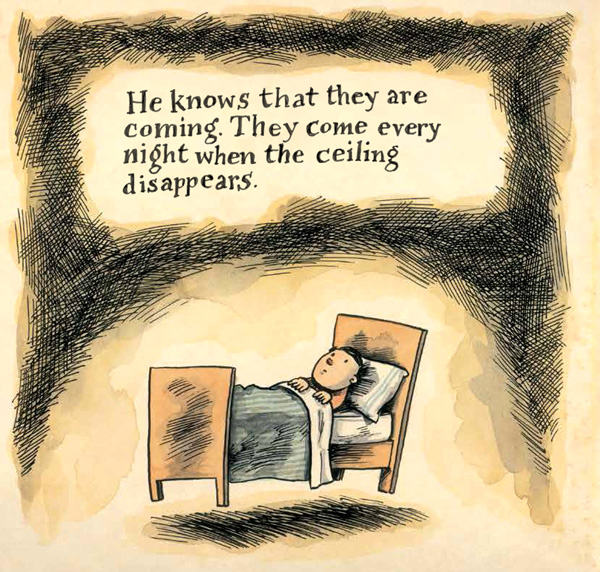
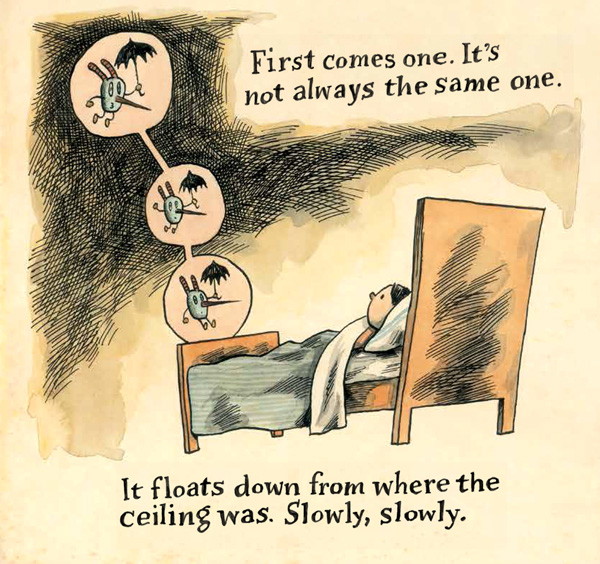
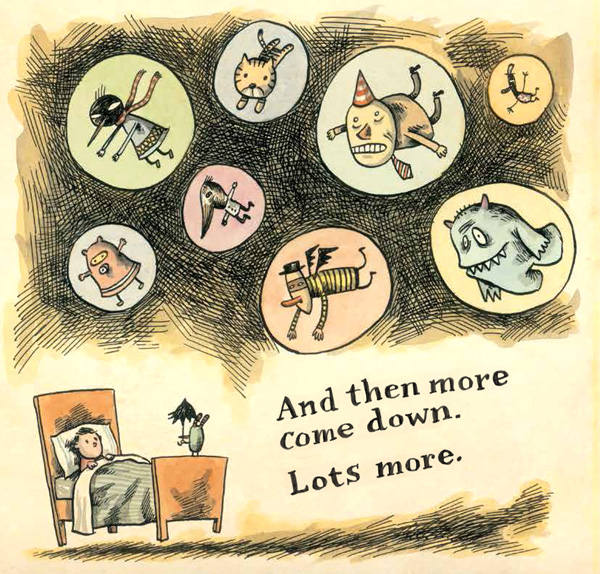
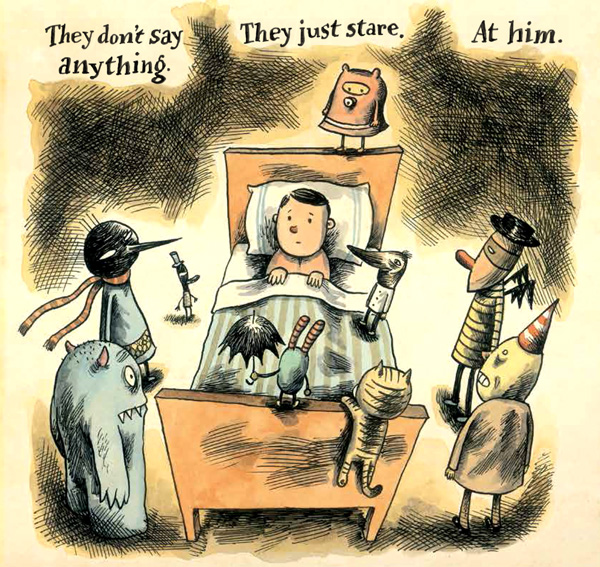
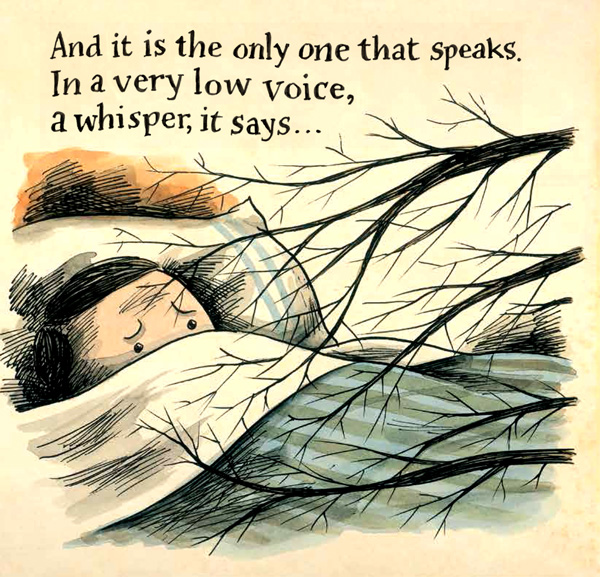
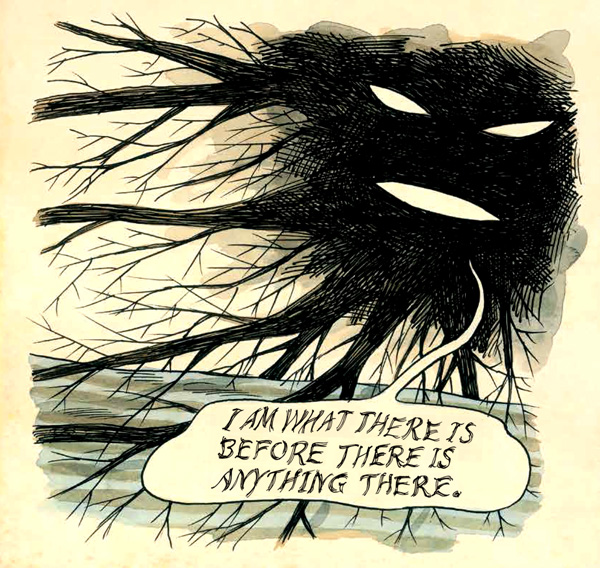
What There Is Before There Is Anything There, a treat in its delightfully spooky yet assuring totality, is translated by Elisa Amado and comes from Canadian independent picture-book publisher Groundwood Books, who also gave us the enormously heartening Migrant, a kind of Alice in Wonderland for the modern immigrant experience. Complement it with a very different take on the same subject in Lemony Snicket’s The Dark, illustrated by Jon Klassen.
Joni Mitchell : interview on creativity
She revisits this notion of creating from a place of freedom rather than normative restriction based on the ideals and shoulds of others:
Mitchell's creative source springs from precisely this feeling of miraculous, wholehearted aliveness. She tells Marom:Freedom to me is a luxury of being able to follow the path of the heart, to keep the magic in your life. Freedom is necessary for me in order to create, and if I cannot create I don’t feel alive.
Much of what we call "inspiration," Mitchell suggests, is really the active practice of finding oneself by getting lost:How does a person create a song? A lot of it is being open, I think, to encounter and to, in a way, be in touch with the miraculous.
I think that as long as you still have questions, the child questions, the muse has got to be there. You throw a question up to the muse and maybe they drop something back on you.

'In the Park of the Golden Buddha,' 1995
When Maron notes that "once you’ve known poverty, it digs into you no matter how successful," Mitchell agrees and admits to being "suspicious of wealth" because she had come from destitution. Looking back on that tipping point when she went from struggling artist to star, with the affluent lifestyle to boot, she contemplates the inner tussle of values:
I had difficulty at one point accepting my affluence, and my success, even the expression of it seemed to me distasteful at one time, like to suddenly be driving a fancy car. I had a lot of soul searching to do. I felt that living in elegance and luxury cancelled creativity, or even some of that sort of Sunday school philosophy that luxury comes as a guest and then becomes the master. That was a philosophy that I held onto. I still had that stereotyped idea that success would deter it, that luxury would make you too comfortable and complacent and that the gift would suffer from it.
But I found that I was able to express it in the work, even at the time when it was distasteful to me... The only way that I could reconcile with myself and my art was to say, “This is what I’m going through now; my life is changing. I show up at the gig in a big limousine and that’s a fact of life.”I’m an extremist as far as lifestyle goes. I need to live simply and primitively sometimes, at least for short periods of the year, in order to keep in touch with something more basic. But I have come to be able to finally enjoy my success, and to use it as a form of self-expression.Leonard Cohen has a line that says, “Do not dress in those rags for me, / I know you are not poor.” When I heard that line, I thought to myself that I had been denying, which was hypocritical. I had been denying, just as that line in that song, I had played down my wealth.Many people in the rock business [have] their patched jeans and their Levi jackets, which is a comfortable way to dress, but also it’s a way of keeping yourself aligned with your audience. For instance, if you were to show up at a rock and roll concert dressed in gold lamé and all of your audience was in Salvation Army discards, you would feel like a person apart.

Leonard Cohen and Joni at the 1967 Newport Folk Festival
Despite how gradual her rise had been and how emblematic of the idea that the myth of the overnight success is indeed a myth,
Mitchell recalls the hollowing feeling of beginning to feel separate
from her audience by a magnitude of wealth. And yet she finds her peace
in a rather Zen-inspired perspective, one where everything that is is
welcome as it is, allowing experience to unfold without the layering of
judgment. Seen that way, poverty and affluence, like meeting and separation
and like most seeming polarities in life, are two sides of the same
coin, two dimensions of the human experience, riddled with many of the
same anguishes and anxieties. (Henry Miller touched on this beautifully
in his 1935 meditation on money, through the parable of the factory owner's predicament.) Mitchell tells Marom:Echoing Georgia O'Keeffe's ideas on mental toughness, she adds:I’m still searching for meaning and purpose. You know, people have a funny idea that success, [that] luxury is the end of the road. That’s not the end at all. As a matter of fact, many troubles begin there. They’re just of a different nature.
I’ve had the experience of poverty, middle class, now extreme wealth and luxury, and that’s difficult too.
But her most eloquent and sensitive articulation of these ideas, fittingly, comes from one of her songs – "The Boho Dance" from her 1976 album The Hissing of Summer Lawns:I live in a beautiful place, like it would be a dream place. Many a day I walk through it and don’t see anything... If I have to live with less, I can do it easily. I can live with much less. As a matter of fact, for my nature, it’s too complicated to have so much because I can never find anything. [laughs] That’s a silly little problem but you don’t need that much. It’s a big headache... I like the luxury of having a swimming pool. But if I could have a shack or a tent down there next to my swimming pool, I’d be very contented. [laughs]
 a>
a>Joni Mitchell: In Her Own Words is a magnificent read in its entirety – a rare glimpse into the inner world of a rare kind of genius. Complement it with Leonard Cohen on the key to the creative life, Bob Dylan on sacrifice and the unconscious mind, Pete Seeger on the myth of originality, and Carole King on overcoming creative block.You read those books where luxury
Comes as a guest to take a slaveBooks where artists in noble povertyGo like virgins to the graveDon’t you get sensitive on me’Cause I know you’re just too proudYou couldn’t step outside the Boho dance nowEven if good fortune allowedLike a priest with a pornographic watchLooking and longing on the slySure it’s stricken from your uniformBut you can’t get it out of your eyes
:: MORE / SHARE ::
http://www.brainpickings.org/
What There Is Before There Is Anything There: Celebrated Cartoonist Liniers Confronts Childhood Nightmares
By: Maria Popova
An imaginative graphic novel about the quintessential childhood fear.
 Children often wonder about why we dream, as do some dedicated researchers, but the question of why we have nightmares
is as perplexing to scientists — some of humanity’s most intelligent
grownups — as it is exasperating to kids. Indeed, nightmares, along with
its sister fear of the dark, are among childhood’s most anguishing and
common experiences, as exasperating to the child experiencing them as to
his or her parents in their helplessness of assuaging them.
Children often wonder about why we dream, as do some dedicated researchers, but the question of why we have nightmares
is as perplexing to scientists — some of humanity’s most intelligent
grownups — as it is exasperating to kids. Indeed, nightmares, along with
its sister fear of the dark, are among childhood’s most anguishing and
common experiences, as exasperating to the child experiencing them as to
his or her parents in their helplessness of assuaging them.That’s precisely what award-winning Argentinian cartoonist and New Yorker cover artist Liniers (whose beloved Macanudo series was just released in English for the first time) explores in What There Is Before There Is Anything There: A Scary Story (public library) — a wonderful picture-book that brings dark humor to those familiar nighttime fears while taking them seriously, at once spooky and sweet in its solidarity of acknowledging that they are very much real, even if their objects are not true. One of the great injustices of childhood, after all, is the recurring experience of not being believed by grownups, not being validated in one’s fears and fancies and subjective truths simply because one is a child. Liniers refuses to negate the realness of those childhood fears and instead meets them with equal parts reassurance, imagination, and gentle wit, in a style reminiscent of Edward Gorey yet distinctively his own.










What There Is Before There Is Anything There, a treat in its delightfully spooky yet assuring totality, is translated by Elisa Amado and comes from Canadian independent picture-book publisher Groundwood Books, who also gave us the enormously heartening Migrant, a kind of Alice in Wonderland for the modern immigrant experience. Complement it with a very different take on the same subject in Lemony Snicket’s The Dark, illustrated by Jon Klassen.
New Media : Virtual World+Real World, Kowloon King of Graffitti & HK demonstration 27sept
There is a new installation of Kowloon Kings work in NeoKowloon Sim. It echos the real world demonstration in Hong Kong. Great art work by Magnum the sim owner. VW+RW



28sept2014 in hk from:山寨音樂 facebook

https://www.youtube.com/watch?v=w4q8fs8gTIs
morning of 29Sept2014



28sept2014 in hk from:山寨音樂 facebook

https://www.youtube.com/watch?v=w4q8fs8gTIs
morning of 29Sept2014
New Media : comic book on Space, a vintage book
from : Brain Pickings
Professor Astro Cat's Frontiers of Space: Rocket Fuel for the Souls of Budding Sagans
 In reflecting on the story of the Golden Record,
Carl Sagan, in his infinite poetic powers, celebrated our destiny as "a
species endowed with hope and perseverance, at least a little
intelligence, substantial generosity and a palpable zest to make contact
with the cosmos." Given how gravely space exploration has plummeted
down the hierarchy of cultural priorities in the decades since Sagan's
time, how can we hope to imbue the hearts of the next generation of
astronauts, policy makers, and cosmic explorers with the passionate
poetics of Sagan's conviction, with the same exhilarating longing to
reach for and embrace the stars?
In reflecting on the story of the Golden Record,
Carl Sagan, in his infinite poetic powers, celebrated our destiny as "a
species endowed with hope and perseverance, at least a little
intelligence, substantial generosity and a palpable zest to make contact
with the cosmos." Given how gravely space exploration has plummeted
down the hierarchy of cultural priorities in the decades since Sagan's
time, how can we hope to imbue the hearts of the next generation of
astronauts, policy makers, and cosmic explorers with the passionate
poetics of Sagan's conviction, with the same exhilarating longing to
reach for and embrace the stars?Professor Astro Cat's Frontiers of Space (public library), written by quantum computer scientist Dominic Walliman and designed and illustrated by Ben Newman, is a heartening step in the direction of an answer. Both modern in its scientific spirit and with a sensibility modeled after the delightful mid-century children's books from the Golden Age of space exploration, it tickles young readers – as well as their space-enchanted parents – into precisely that "palpable zest to make contact with the cosmos."


From clever visualizations of the scale of the universe to an illuminating primer on how stars are born to an illustrated anatomy of NASA's Curiosity Rover, the book combines solid science (pause for a moment to consider the size of the gaseous giant Jupiter, inside which 1,300 Earths can fit) with curious untrivia (I find poetic symbolism in the fact, previously unknown to me, that Venus spins in the opposite direction to all other planets in the Solar System, and how neat to know that the surface of the moon equals the size of Africa), binding it all together with subtle humor and wholehearted joy in learning.






What makes the book particularly wonderful is that it refuses to do the great disservice to science that textbooks often do, which is to insinuate having all the answers. Instead, it embraces the awareness that science thrives on "thoroughly conscious ignorance" and dedicates a good portion of the story to as-yet unanswered questions, like whether there is other intelligent life in the universe and what the human future in space might look like if we transplanted our civilization on other planets.



Professor Astro Cat's Frontiers of Space comes from the treasure chest of British indie children's book press Flying Eye Books, which also gave us that sweet celebration of connection and inner softness, the delightful field guide of mythic monsters, and the illustrated chronicle of Shackleton's historic polar expedition.
Complement it with this remarkable vintage children's book, which envisioned gender equality and ethnic diversity in space exploration decades before either became a reality, then revisit the wonderful You Are Stardust, which teaches kids about the universe in lyrical illustrated dioramas.
:: MORE / SHARE ::
New Media: Reading/ Camus on happiness
from : Brain Pickings
For Camus, the question of meaning was closely related to that of happiness – something he explored with great insight in his notebooks. Zaretsky writes:

But his most piercing point integrates the questions of happiness and meaning into the eternal quest to find ourselves and live our truth:
:: MORE / SHARE ::
For Camus, the question of meaning was closely related to that of happiness – something he explored with great insight in his notebooks. Zaretsky writes:
Perhaps most importantly, Camus issued a clarion call of dissent in a culture that often conflates happiness with laziness and championed the idea that happiness is nothing less than a moral obligation. A few months before his death, Camus appeared on the TV show Gros Plan. Dressed in a trench coat, he flashed his mischievous boyish smile and proclaimed into the camera:Camus observed that absurdity might ambush us on a street corner or a sun-blasted beach. But so, too, do beauty and the happiness that attends it. All too often, we know we are happy only when we no longer are.
This wasn't a case of Camus arriving at some mythic epiphany in his old age – the cultivation of happiness and the eradication of its obstacles was his most persistent lens on meaning. More than two decades earlier, he had contemplated "the demand for happiness and the patient quest for it" in his journal, capturing with elegant simplicity the essence of the meaningful life – an ability to live with presence despite the knowledge that we are impermanent:Today, happiness has become an eccentric activity. The proof is that we tend to hide from others when we practice it. As far as I’m concerned, I tend to think that one needs to be strong and happy in order to help those who are unfortunate.
[We must] be happy with our friends, in harmony with the world, and earn our happiness by following a path which nevertheless leads to death.

But his most piercing point integrates the questions of happiness and meaning into the eternal quest to find ourselves and live our truth:
A Life Worth Living: Albert Camus and the Quest for Meaning comes from Harvard University Press and is a remarkable read in its entirety. Complement it with Camus on happiness, unhappiness, and our self-imposed prisons, then revisit the story of his unlikely and extraordinary friendship with Nobel-winning biologist Jacques Monod.It is not so easy to become what one is, to rediscover one’s deepest measure.
:: MORE / SHARE ::
Sunday, September 28, 2014
New Media: Virtual World visits: "osyare sept2014"
http://youtu.be/dQoA__pRBGM
Swannjie visits all the nice sims created in sl before scenaries changed.
Osyare, a sim which features vinyl disk musics. Retro Japanese ambiance.
Swannjie visits all the nice sims created in sl before scenaries changed.
Osyare, a sim which features vinyl disk musics. Retro Japanese ambiance.
Saturday, September 27, 2014
New Media: micro tig welding
https://www.youtube.com/watch?v=Du38DBUd4DM
micro tig welding practice
https://www.youtube.com/watch?v=2PPvtOW3Xpk
DIY pulse arc welder
micro tig welding practice
https://www.youtube.com/watch?v=2PPvtOW3Xpk
DIY pulse arc welder
Friday, September 26, 2014
Thursday, September 25, 2014
New Media : Garden real life vegetation and Digital Art, Algorithm flowers at Chaumont-s-Loire; Digital flowers by Miguel Chevalier 2014
Chaumont-sur-Loire, Garden Festival 2014
Every year I go to Chaumont-s-Loire, to see the Loire valley river, see the little villages along the way from Paris - you drive 3 hrs, and then, slowly you enter the Loire valley region, and its beautiful. All along the way, the tiniest villages, everything is so clean, not many pedestrians anywhere. Sunny.
This time, I noticed there were 3d printings models of digital flowers, these growth of flowers using algroithm. As the visitor pass infront of the display, the digital flowers falls to one side, then another side. Not much new here, but very nice looking flowers. On smaller screens, see see automatic growth of flowers, they grow, become vibrant, beautiful colors and shapes, geometric forms, expands into massives lines, then fades out, another grows from the bottom of the screen. Always beautiful shapes and forms. Artist: Miguel Chevalier
The other installations are voices, memories, garden shapes and forms. Interior dialogue type of work.
Coming up to the special installation gardens, the theme is "sins"... almost all of the installations has to do with the 7 deadly sins. Very christian themes. The gardens are more or less different types of plants, hard, soft, dark, light, red, sitting, looking, reflecting, water pools. Papyrus of different varieties. Red flowers.
Then, we go down to the valley of the mist - a watering pipe system with many tiny sprouts that produces mists. Very misty walk, v nice.
The entire garden festival is very festive and green.
I almost always want to know immediately which plants are what, and if we could grow some of these ourselves. But by the way I reach the exit to the seed shop, I have already forgotten which plants were which.
The whole visit lasted 2.5hr approximately.
Sometimes I think, if the gardens are allowed to reach maturity year after year, would you have a more timeless type of work? Instead of like a temporary display, that is soon to be forgotten?
Maybe it take much more planning then and would be another structure altogether and wouldnt be a yearly event.
But I know I will want to come again next year!
I will want to see what will be the next theme?
So many interesting plant lives. Great idea.
Pictures coming...
Subscribe to:
Posts (Atom)



